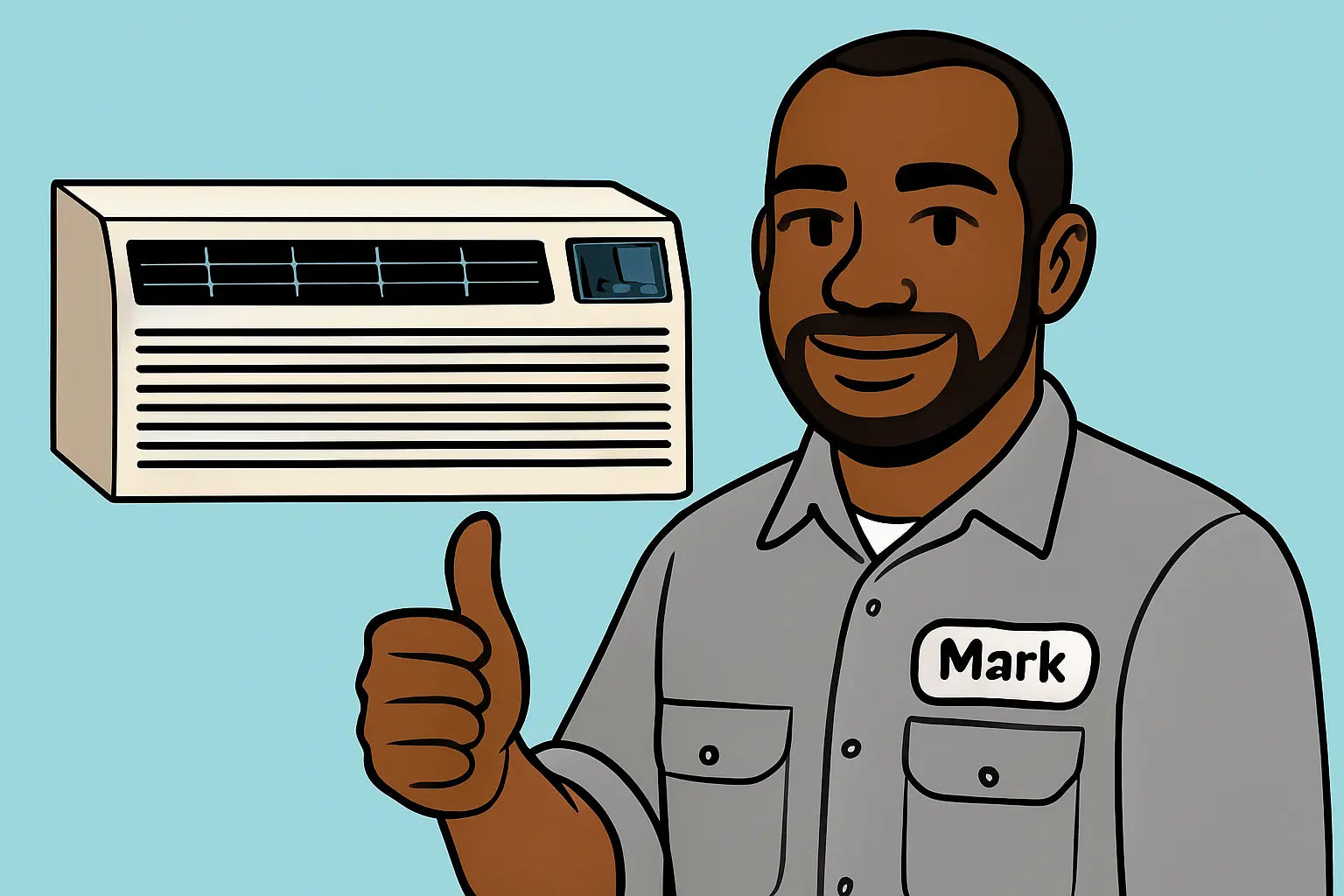Intro from Mark
Hey, it’s Mark here, your HVAC straight shooter. Today, we’re talking about one of the most overlooked but critical parts of buying a PTAC: sizing it right. Buy too small, and your space never feels cool or warm enough. Buy too big, and you’re wasting money and energy like a rookie. So I’m here to help you avoid those rookie mistakes and get a sizing game plan that works perfectly for your room or building. Grab a coffee ☕, and let’s dive in.
Why Proper Sizing Matters
A PTAC unit that’s too small will run all day, struggling to keep up. That’s bad news for your electric bill and your comfort. On the flip side, an oversized unit will cycle on and off too often, which wears down parts faster, wastes energy, and leaves you with uneven temps and humidity issues.
If you want the science behind why right-sizing matters, the U.S. Department of Energy explains the efficiency impact here.
What Is BTU and Why It’s Critical
BTU measures the amount of heat an air conditioner can remove or a heater can add in an hour. The higher the BTU rating, the bigger the space it can handle. For the Amana Distinctions PTACs, you’re typically looking at sizes from around 7,000 BTU up to 15,000 BTU.
Think of BTU like the horsepower of your PTAC’s climate muscle: more horsepower = bigger job done right. If you want a deeper dive into how BTU ties into heating and cooling load, HVAC.com has a straightforward breakdown.
Key Factors to Consider When Sizing Your PTAC
Room Size (Square Footage)
This is the biggest factor. The general rule of thumb? You need about 20 BTUs per square foot of living space to cool or heat efficiently.
Ceiling Height
Standard sizing assumes an 8-foot ceiling. If your ceilings are higher, you need to bump up your BTUs accordingly because more air means more work.
Insulation & Windows
Well-insulated rooms with double-pane windows hold temp better, meaning you can stick closer to the base BTU number. Poor insulation or drafty windows? Size up. Energy Star explains how insulation impacts HVAC efficiency here.
Sunlight Exposure
A room baking in direct sun most of the day needs more cooling power. North-facing rooms generally need less cooling.
Occupancy and Equipment
More people generate heat. If the room regularly hosts crowds or has heat-producing equipment, size up.
How to Size an Amana PTAC Step by Step
-
Measure Your Room – Length × Width = Square footage
-
Calculate Base BTUs – Multiply square footage × 20 BTUs
-
Adjust for Other Factors – Increase for high ceilings, poor insulation, sun exposure, or multiple occupants
-
Match to Available Models – Choose the closest model at or above your adjusted BTU need
If you want a pro-level load calculation, check out this Manual J sizing calculator from Cool Calc.
Example: Sizing a 12x15 Room with High Ceilings and Big Windows
-
Room size = 180 sq ft
-
Base BTUs = 180 × 20 = 3,600 BTUs
-
High ceiling: +15% → 4,140 BTUs
-
Large, single-pane windows: +15% → 4,761 BTUs
-
3 regular occupants: +10% → 5,237 BTUs
You’d be looking at roughly a 5,200 BTU unit minimum. Amana’s lineup means you might step up to a 7,000 or 9,000 BTU model to match availability.
Why Not Oversize Your PTAC?
Oversizing might seem like an easy fix—more power means faster cooling, right? Nope. When your PTAC cycles on and off too quickly (short cycling), it doesn’t properly dehumidify the air, making the room feel clammy. HVAC School does a great job explaining short cycling here.
Pro Tips for Choosing Your PTAC
-
Factor in climate zone—hotter areas require more BTUs
-
Don’t ignore heating BTU specs if you rely on electric heat strips
-
Check SEER ratings for cooling efficiency
-
If in doubt, get a professional heat load calculation
Wrap Up from Mark
Sizing your PTAC right is like Goldilocks’ porridge—not too big, not too small, but juuuust right. Do the math, account for your room’s quirks, and you’ll stay comfortable without burning through your wallet. If you’re ready to size up the real deal, check out the Amana Distinctions 12,000 BTU PTAC with 3.5 kW electric heat and see if it fits your space like a glove. And hey, if the numbers make your head spin, there’s no shame in calling in a pro.
Need wiring tips for this unit? Visit: Electrical Wiring Essentials for Installing Your Amana PTAC.
Stay sharp, keep your cool, and I’ll catch you in the next one.
- Mark out! ✌️🔥







